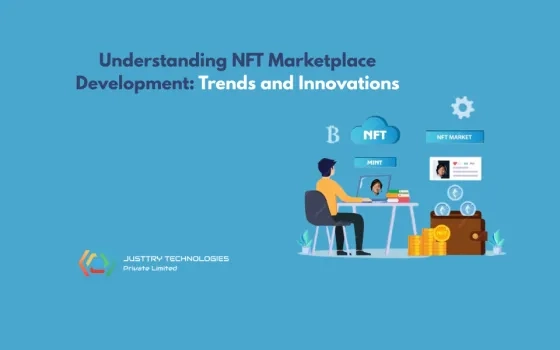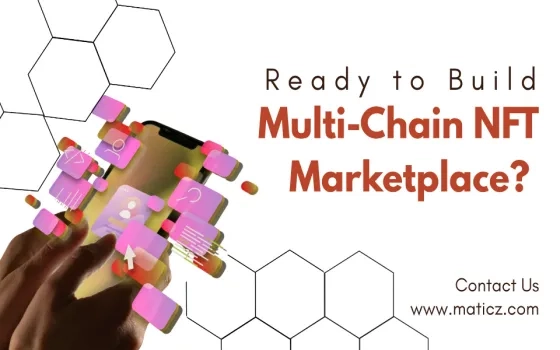The rapid evolution of Web3 applications has necessitated the need for a multichain compatible application to enable seamless interaction across diverse blockchain networks. NEAR chain signatures is one of the major drivers of interoperability in this regard. This article examines restructuring the development of multicoin-web3 apps focusing on integrating NEAR Chain Signatures.
In recent years, Blockchain ecosystems have been expanding, making it necessary to communicate and work together between different chains. NEAR Protocol, known for its scalability and developer-friendly features, plays a pivotal role in facilitating this interoperability through its innovative chain signature mechanism.
We aim to describe how developers can improve their multi-chain Web3 applications by exploring the potential and benefits of NEAR chain signatures. Now we shall dig deeper into the world of near chain signatures and see if we can understand how they are changing decentralized apps landscape.
Understanding NEAR Chain Signatures
NEAR is a standout platform in the world of web 3 applications as it enables interconnectivity between different blockchain networks using NEAR cross-chain integration. In enabling cross-chain communication and data transfer, NEAR Protocol acts as an important intermediary that fosters seamless integration among these chains using nearchain signatures.
- Introduction to the NEAR Protocol and NEAR Cross-Chain Integration
Scalability, developer friendliness, robust infrastructure are some of the features that make Near protocol popular for building dApps. The NEAR Cross-Chain Integration term refers to unobstructed linking-up and communication between the NeAr protocol and other blockchains resulting in asset exchange or movement, data sharing or use from various chain accounts respectively.
- Exploring NEAR Chain Signatures
NEARCHAIN SIGNATURES: These cryptographic proofs allow one to verify authorizations within near’s realm while ensuring that transactions remain secure even across multiple chains with no leakage in exchanged data sets. They will enhance interoperability among developers’ applications hence enabling different functionalities via cross-chains thus unlocking new opportunities for developers to leverage on.
- Advantages of NEAR Chain Signatures for Multichain Applications
The adoption of NEAR chain signatures offers several key benefits for developers looking to create multichain Web3 applications. Those include increased security, higher scalability, reduced transaction rates and better management of cross-chain operations. Integrating Near chain signatures in projects can optimize application performance, functionalism while integrating with diverse blockchains.
We continue our journey into the world of near chain signatures and their role in near cross-chain integration revealing why these technologies are so transformative for decentralization. Let’s see what other insights and implementation strategies we have about leveraging near chain signatures in multi-chain web3 development.
Challenges in Creating a Multichain Web3 App
Web3 app development is characterized by unique challenges such as integrating multiple blockchain networks that must be overcome by developers to ensure that their apps run smoothly. An endless number of hurdles may arise when an app developer goes into the realm of multichain web3 apps that undermines project efficiency and effectiveness. Some major obstacles faced in creating a multicoin-web3app and how NEAR Chain Signatures can help with these are discussed here.
- Compatibility Issues Across Different Blockchain Networks
One of the main tasks in developing multichain Web3 applications is ensuring compatibility and interoperability on diverse blockchain networks. Various blockchains have their own protocols, consensus mechanisms, and smart contract languages. It is therefore difficult to come up with an app that will be used across multiple chains concurrently. NEAR Chain Signatures are globally accepted standards for authenticating and sharing data between chains that differ from one another.
- Complications when Managing Multiple Chain-Specific Implementations
For developers, many chain-specific implementations can be too much to handle because different coding languages, APIs, and network configurations must be juggled. As a result of this complication, the development process may also become inefficient or delayed due to various errors being committed in the course of its implementation. The use of NEAR chain signatures by developers can enable integration of multiple chains into their applications in a way that reduces complexity associated with managing disparate implementations and allows for more streamlined and efficient development processes.
- Possible Security Vulnerabilities
Web3 application development prioritizes security especially when it comes to working with several blockchain networks as well as cross-chains interactions. Decentralization endows blockchains with special risks including compromised smart contracts, data leakages and unauthorized access among others. NEAR Chain Signatures offers secure methods for validating transaction and maintaining data integrity on different chains thereby reducing security threats while enhancing overall robustness of multi-chain Web3 apps.
Revising Development Process
Developers need to change their development process to cater for the unique challenges involved in integrating different blockchains so as to meet the growing demand for multichain Web3 apps. By adopting a new approach to web 3 application development; teams are able to enhance efficiency as well as scalability and security within multichain environments through utilization of NEAR chain signatures. In this section we will look at key strategies towards restructuring the development process which enable optimization of NEAR Chain Signature integration.
- Adopting Modular/Extensible Architecture
Adopting a modular and extensible architecture is one way in which developing multichain Web3 apps can be streamlined effectively. This strategy involves breaking down an app into smaller reusable components that can easily be integrated with different blockchains. Developing a modular structure facilitates the separation of chain-specific logic from the core application logic thus allowing for addition or deletion of support for different blockchains without interfering with other parts of the system.
- Separating Chain-Specific Logic from Core Application Logic
To attain a modular and extensible architecture, it is imperative that chain-specific logic is separated from core application logic. If specific blockchain network changes or updates, this separation will guarantee that overall functionality of that application is not affected negatively. By encapsulating specific code associated with chains in separate modules, developers can interchange these modules whenever necessary without having to change the other parts of the whole application.
- Using Cross-Chain Communication Protocols and Libraries
Cross-chain communication protocols and libraries are tools that developers use to facilitate seamless communication between different blockchain networks. Through such tools, applications have a standardised approach to interacting with multiple chains reducing complexity associated with managing inconsistent network configurations and APIs. For effective development process, team should therefore include cross-chain communication protocols into their frameworks during integration of NEAR Chain Signatures as well as other features unique to specific blockchains.
Implementation NEAR Chain Signatures
Having studied multichain Web3 application development process restructuring following, we can now dive into the practical aspects of implementing NEAR Chain Signatures. In this part, we explain how to go about setting up a NEAR Protocol Development Environment, generating and managing NEAR Chain Signatures and integrating them in to your application’s authentication and authorization processes.
- Setting up the NEAR Protocol Development Environment
To start implementing NEAR Chain Signatures, you will be required to setup a NEAR Protocol development environment. This involves installing needed dependencies, configuring your development tools and getting acquainted with the SDK and APIs of the NEAR Protocol. To assist developers in getting started, the NEAR Protocol provides extensive documentation and resources for smooth onboarding.
- Generating and Managing NEAR Chain Signatures
Near-chain signatures help secure cross-chain transactions and ensure that exchanged data is genuine. To generate and manage these signatures, you need first have created some near accounts then set up key pairs for signing transactions. There are many tools from which one can generate keys using libraries like Near SDK or command-line interface (CLI) called Near CLI which is also available in most programming languages.
- Integrating NEAR Chain Signatures into Application’s Authentication and Authorization Processes
For integration purposes one must have already produced their own near chain signatures into their application’s authentications as well as permission procedures. In order to handle near chain signature verification plus authorization checks on your app code change is required. The Near software development kit has functions that help verify signatures among other things that only authorized users within your app perform some actions.
Optimizing Performance and Scalability
In today’s world of multi-chain Web3 applications performance optimization together with scalability are very crucial so as to give an effective user experience by making sure it operates faster with ease between different chains of transactions. By using a proper implementation strategy for Near chain signatures developers can improve speed as well as keep up with high transaction volumes and user concurrency. This section will explore how to reduce latency, improve response time, and optimize the performance of NEAR Chain Signature-enabled applications using scalability features from Near Protocol.
- Techniques for Minimizing Latency and Improving Response Times
Reducing latency and increasing response times are key factors in improving the overall performance of multichain Web3 applications. By optimizing network configurations, implementing caching mechanisms and designing efficient ways of retrieving data, developers can lower the processing time that takes place before transactions are confirmed. In addition, developers can distribute work well by leveraging asynchronous processing as well as parallel computing techniques which can enhance application’s responsiveness.
- Strategies for Handling High Transaction Volumes and User Concurrency
Performance cannot be a compromised no matter how popular multi-chain web3 applications become and they should therefore be built with ability to handle high transaction volumes concurrently. Developers can guarantee that their apps remain both responsive and dependable even when there is heavy traffic through load balancing, database optimization queries or dynamic scaling of resources. Another approach is sharding which involves dividing this system into smaller parts hence allowing more users or transactions by making use of NEAR Protocol’s other feature called parallel processing.
- Leveraging the NEAR Protocol's Scalability Features
Among the developers, NEAR Protocol has many scalability features that they can exploit to improve on their applications’ performance. This may involve techniques like sharding, parallel execution, and state pruning among others that help in resource optimization as well as enhanced throughput of transactions and lowered processing overhead. These scaling features will ensure smooth user experience in Near Chain Signature enabled applications as the number of users grows.
Security Considerations
Web3 Applications must be secure since it is built with security prioritized. Developers must prioritize security measures integrated into multichain apps using NEAR Chain Signatures to protect against potential threats and preserve data integrity and transactional validity. In this section, we will go through important security considerations to note when employing NEAR chain signatures safely.
- Implementing robust security measures for NEAR chain signatures
Securing NEAR Chain Signatures is very important because it helps to prevent unauthorized access or data breaches among other vulnerabilities related to its safety. Therefore, there is need for developers to put in place strong security measures such as multi-factor authentication, safe key storage practices and routine safety audits for Near Chain Signature purpose. Additionally, by utilizing HTTPS protocols for secure transmission plus encrypting vital information would strengthen overall app security.
- Protecting Against Common Web3 Security Threats
Web3 applications face unique security risks including smart contract bugs; phishing; unscrupulous actors exploiting system weaknesses among others. Proactive mitigation strategies include adherence to best industry practices regarding security as well being updated on emerging cyber threats which inform the choice of technologies used during development. Such includes updating dependencies regularly, performing scheduled audits on the platform’s codebase and having a functional monitoring system with an alert mechanism embedded within.
- Ensuring Compliance with Industry Standards and Best Practices
Developers have to make sure that their implementation of NEAR Chain Signatures meets industry standards and adopts best practices so that they can maintain high levels of both reliability and security. This includes following guidelines set forth by organizations such as the Web3 Security Foundation and the Blockchain Security Alliance. Aligned to these standards, developers can further demonstrate their commitment to security thereby building confidence with users and other interested parties.
Testing and Deployment
Developing a multichain Web3 application that is of high quality, reliable, and stable is very important. Thus, when deploying NEAR Chain Signatures, it is necessary for developers to have in place thorough testing strategies as well as streamlined deployment pipelines that will validate functionality, security and performance of applications. In this section we will discuss some of the best practices for testing and deploying NEAR Chain Signature-enabled applications that will ensure successful rollout.
- Comprehensive Testing Strategies for Multichain Web3 Applications
To ensure flawless functioning of multi-chain web 3 apps; developers should adopt comprehensive testing strategies capable of validating functionality, security features and performance levels. These could include series of unit tests specifically designed to check if individual components function correctly in isolation; integration tests aimed at ensuring seamless communication between different modules; end-to-end tests simulating real world user scenarios. By doing this type of development process at each stage—testing—developers are able get rid of bugs before they become big problems that demand expensive post-deployment fixes.
- Continuous Integration and Continuous Deployment (CI/CD) Pipelines
Streamlining the deployment process and achieving consistent and reliable releases would require developers to embrace continuous integration and continuous deployment (CI/CD) pipelines. By automating build, testing, and deployment processes, these pipelines reduce manual intervention and minimize risks of human errors. When NEAR Chain Signature Validation is integrated with CI/CD pipeline the developer ensures only correctly signed and authorized codes are deployed in the production environment thus; improving both security and reliability of the application.
- Deployment Considerations for NEAR Chain Signatures
Among other things, a developer must consider network configuration, key management, transaction monitoring among others when deploying applications that employ NEAR Chain Signatures. It’s important to have them adequately integrated into the application’s authentication and authorization mechanisms so as to maintain its integrity and security. Additionally establishing proactive monitoring systems that keep track of transactions for deviations can help in real-time discovery of potential security threats or performance related issues.
Real-world examples and case studies
Many projects have embedded this technology in their multi-chain Web3 applications as NEAR Chain Signatures continues being adopted widely. In this section we will look at some real life examples / case studies illustrating how implementing Near chain signatures has worked or failed within specific use cases.
- Case Study: Decentralized Finance (DeFi) Platform
For instance, one DeFi platform that used NEAR Chain Signatures was able to facilitate cross-chain lending & borrowing smoothly through it. By integrating NEAR Chain Signatures they enabled secure transactions between different blockchain networks making it appear as one user interface for users on any blockchain platform on which they operate. This implementation saw user traction increase significantly with more transactions recorded thereby indicating that Near chain signatures have potential in DeFi space.
- Case Study: Gaming Platform
However another example is a gaming platform that was using NEAR Chain Signatures to allow multi-blockchain transfers of assets across chains as well as verifying ownerships.. With these there were no issues regarding security or the smoothness of its operations hence users could effectively transfer assets among games that ran on various blockchain-based platforms. This implementation improved and reduced both transaction times and costs enabling more effective gaming processes to occur.
- Case Study: Supply Chain Management
A supply chain management platform also successfully integrated NEAR Chain Signatures to enable secure and transparent tracking of goods across different blockchain networks. By leveraging NEAR Chain Signatures, the platform was able to provide real-time tracking and verification of goods, reducing the risk of counterfeiting and increasing supply chain efficiency. This implementation demonstrated the potential of NEAR Chain Signatures in industries beyond
- Challenges and lessons learned
However these case studies provide insight into challenges faced during development as well as what can be learnt from implementing Near chain signatures. Major areas addressed below include complexity management, scalability assurance as well as security threat mitigation. Developers learn from each other through sharing experiences with their implementations on Near chain signature.
These real-world examples and case studies showcase the versatility and potential of NEAR Chain Signatures in various industries and use cases. There are even chances that more innovative applications will be developed following the widespread adoption of NEAR Chain Signatures hence expanding opportunities for multichain Web3 development further.
Conclusion
To sum up, NEAR Chain Signatures’ integration into multi-chain Web3 applications is a powerful approach to enable seamless cross-chain interaction, strengthen security and enhance user experience. By reshaping the development process to suit peculiarities of NEAR Chain Signatures, developers can exploit new opportunities for innovation as well as interoperability in the decentralized ecosystem. We have witnessed through practical examples and case studies that proper implementation of NEAR Chain Signatures has several advantages such as increased users’ adoption, improved transaction speed and enhanced safety.
NEAR chain signatures will continue to be an important aspect in Web3 context as it keeps on changing. Developers who are at the vanguard of this technological change will put themselves ahead for success in the ever-expanding realm of decentralized applications. For instance, whether you’re constructing a DeFi platform, gaming system or a supply chain management solution, NEAR Chain Signatures provide a strong instrumentality for unlocking the potential of multichain-web3 development altogether



























